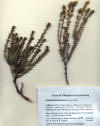|
Leptodactylon caespitosum
|
Leptodactylon californicum
|
|
Leptodactylon pungens Kern Co., CA. Just
below Mt. Abel (Cerro Noroeste), road banks in Jeffrey pine forest
region with Arctostaphylos parryana, Eriophyllum jepsonii,
Eriastrum densifolium. 29 June 2016 |
|
|
Leptodactylon pungens
|
Leptodactylon pungens
|
|
Leptodactylon pungens Utah—Great Basin Desert-Bonneville Basin Region. Millard Co., Confusion Range, north side of Hwy 50, ~92 miles west of Delta; 39º04'42.7", 113º43.08.9", 1716 m. Limestone-sandstone outcrops in pinyon-juniper zone. Loosely branched, wiry-stemmed shrub with dried-out blue flowers. Common on sand lying over limestone. Sample of entire plant (rt-rh-wst-lf). Richard Spjut & Paul Burchstead 16363, 22-June-08.
|
Leptodactylon pungens
|
|
Trees and Shrubs of Kern County (Jan 2013) Leptodactylon pungens (Cantua pungens Torrey 1828) Rydberg 1906 [Linanthus pungens (Torrey) J.M. Porter & L. A. Johnson 2000; includes Leptodactylon pungens ssp. pulchriflorum (Gilia pungens ssp. pulchriflora Brand 1913) Mason 1951; L. pungens var. hallii (Gilia hallii Parish 1899) Jepson 1925]. Subshrub <1/2 m, hairy glandular throughout, leaves alternate, digitately divided into 3–7 sharply pointed, needle-like segments, directly attached to stem, the middle segment longer than the others; flowering Apr–Jul, or sometimes as late as Aug, opening more during the evening, funnelform, white or pinkish; fruit a three-valved capsule. Rocky places in the desert between 4,000 and 13,000 ft, California to Washington, to central Nebraska to New Mexico. Type from valley of the Loupe Fork, NV. Kern Co.: Breckenridge Mt., Piute Mt., Mt. Pinos, Sawmill Mt., Mt. Abel, southern Kern Plateau, Mt. Owen, Long Valley [Keeler-Wolf 1990]; 1,982–2,682 m (CCH). Six other species in the genus (Grant 1998). References Bell, C. D. and R. W. Patterson. 2000. Molecular phylogeny and biogeography of Linanthus (Polemoniaceae). Amer. J. Bot. 87: 1857–1870. Johnson, L. A., L. M. Chan, T. L. Weese, L. D. Busby, S. McMurry. 2008. Nuclear and cpDNA sequences combined provide strong inference of higher phylogenetic relationships in the phlox family (Polemoniaceae). Molecular Phylogenetics and Evolution 48: 997–1012. Grant. V. 1998. Primary classification and phylogeny of the Polemoniaceae, with comments on molecular cladistics. Amer. J. Bot. 85: 741–752. Grant. V. 2003. Incongruence between cladistic and taxonomic systems. Am. J. Bot. 90: 1263–1270. Porter, J. M. 1996 [1997]. Phylogeny of Polemoniaceae based on nuclear ribosomal internal transcribed DNA sequences. Aliso 15: 57–77. Porter, J. M. and L. Johnson. 2000. A phylogenetic classification of Polemoniaceae. Aliso 19: 55–91.
|
|








